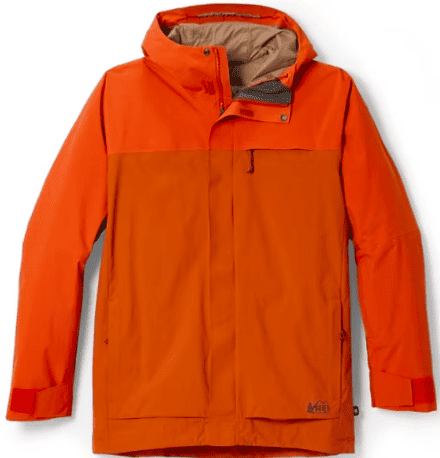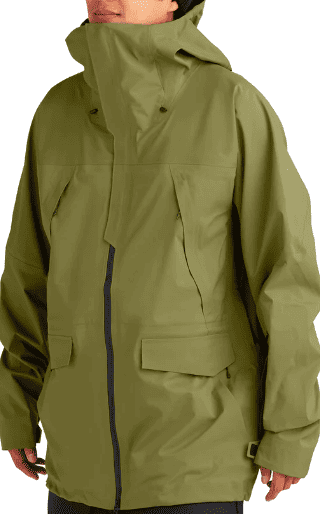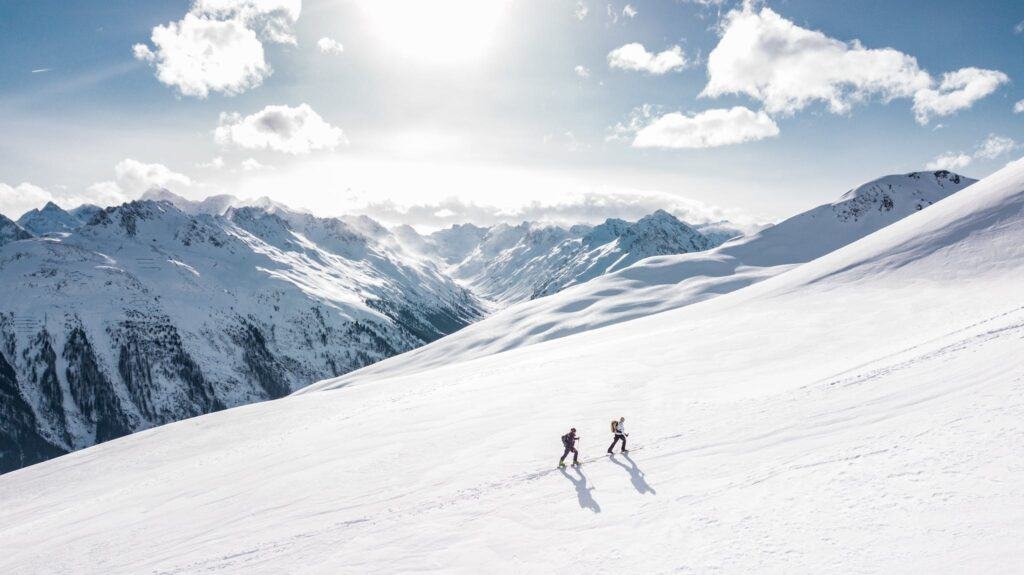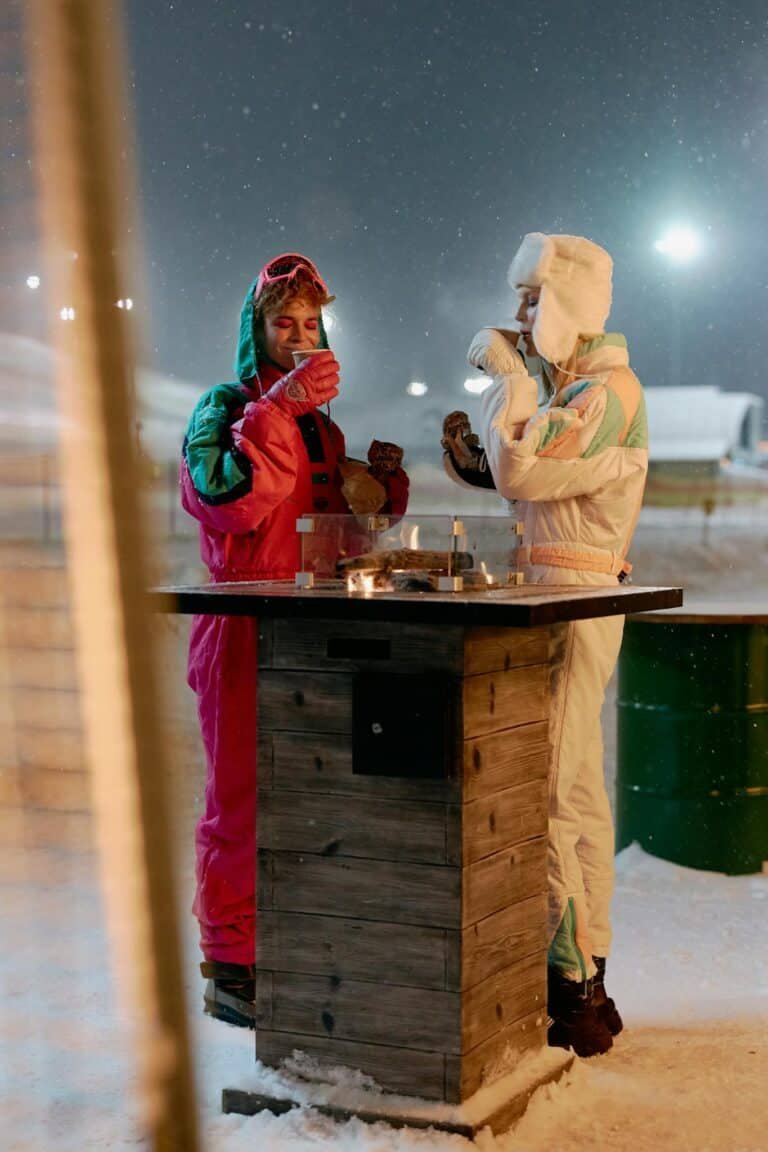9 Best Ski Jackets of 2023-2024

Over the years, ski jackets have evolved from big, bulky garments to sophisticated, multi-functional gear. As the 2023-2024 ski season approaches, selecting the right ski jacket becomes an important decision for enthusiasts and professionals alike. From breathable and lightweight shells to insulated models that keep the cold at bay, the variety available today is a testament to the advancements in fabric technology and design
I listed down the best ski jackets by looking at different types, how they can be worn with other clothes, how waterproof they are, and how well they breathe. You can check the comparison table for a quick peek and our buyer’s guide to learn more about ski jackets. For women-specific ski jackets, read our article about the best women’s ski jackets for guidance.
Top Picks
Best Overall: Arc’teryx Sabre
Best for Resort Skiing: Helly Hansen Alpha 4.0
Best for Backcountry Skiing: RAB Khroma Cirque Jacket
Best Budget Ski Jacket: REI Co-op Powderbound Insulated Jacket
Best 3-in-1 Ski Jacket: The North Face ThermoBall
Best for Colder Days: Mountain Hardwear First Tracks Down Jacket
Comparison Table
| Name | Best Use | Weight (g) | Waterproofing | Type of Jacket |
|---|---|---|---|---|
| Arc’teryx Sabre | Big Mountain Skiing / Backcountry Skiing / Freeride & Freeride Touring / Ski/Snowboard | 705 | 3L GORE-TEX | Shell |
| Helly Hansen Alpha 4.0 | Resort Skiing | 1150 | 2L HELLY TECH® PROFESSIONAL | Insulated |
| RAB Khroma Cirque Jacket | Backcountry Ski Touring / Ski Mountaineering | 425 | 3L Gore-Tex Active | Shell |
| REI Co-Op Powderbound Insulated Jacket | Snowsports / Downhill Skiing | 822 | 2L Peak | Insulated |
| North Face ThermoBall Eco-Snow Triclimate | Resort Ski | 1157 | DryVent™ 2L | 3-in-1 |
| Mountain Hardwear First Tracks | Skiing/Snowboarding, Snowsports | 1113 | 2L Dry. Q | Insulated |
| Stio Environ Jacket | Resort / Backcountry Skiing | 822 | PeakProof 3L | Shell |
| Dakine Sender Stretch 3L | Resort Ski | – | 3L Plain Weave membrane | Shell |
| Marmot Lightray | Downhill Ski / Snowsports | 810 | 2L Gore-Tex | Shell |
Best Overall
Arc’teryx Sabre (Revised)

Best Use: Big Mountain Skiing / Backcountry Skiing / Freeride & Freeride Touring / Ski/Snowboard
Waterproofing: 3L GORE-TEX
Fit: Regular
Weight: 705g
Likes: Great protection and versatility
Dislike: Less ideal for extended backcountry use due to its weight
The Sabre Jacket by Arc’teryx is a testament to the masterful design, tailored to meet the exhilarating and demanding nature of freeride skiing and snowboarding. This jacket is meticulously crafted to respect the challenging realities of mountain environments, offering a protective shield against the elements.
Engineered for snowsports, the Sabre Jacket is equipped with features that enhance protection, layering, and movement, making it an ideal choice for skiers and snowboarders alike. The heart of its design lies in the N80p-X 3L GORE-TEX fabric, a material celebrated for its exceptional ability to ward off wind and wet conditions, including driving snow. This waterproof, windproof, and breathable textile ensures complete environmental shelter, keeping you dry and comfortable in varying weather conditions.
The Sabre Jacket stands out for its thoughtful design elements. The helmet-compatible StormHood™ is adjustable to maximize peripheral vision, crucial for safety and awareness in the backcountry. Additionally, the inclusion of a RECCO™ reflector enhances the jacket’s safety profile, aiding in search and rescue situations. The jacket’s fit is carefully considered – regular, yet not restrictive, allowing freedom of movement with enough room for layering.
Attention to detail is evident in every aspect of the jacket’s construction. It features articulated patterning for unrestricted mobility, adjustable cuffs with Velcro® closures, and a DWR (Durable Water-repellent) finish that repels moisture effectively. The pocket configuration is generous and practical, including two hand pockets with zippers, a zippered internal security pocket, two internal dump pockets, and a zippered sleeve pocket for RFID passes.
The Sabre Jacket is committed to sustainability, incorporating materials that meet the bluesign® criteria. The jacket also features a powder skirt with a stretch panel and gripper elastic, enhancing its utility for snowsports. Its full front zip and updated design lines, including a second internal mesh dump pocket, add to its technical prowess.
Best for Resort Skiing
Helly Hansen Alpha 4.0

Best Use: Resort Skiing
Waterproofing: 2L HELLY TECH® PROFESSIONAL
Fit: Regular
Weight: 1150g
Likes: Good fit that gives maximum freedom of movement
Dislike: Warm during highly active skiing
The Helly Hansen Alpha 4.0, a top choice for resort skiing, has been enhanced for optimal performance on the slopes. This jacket features HELLY TECH® PROFESSIONAL construction, making it waterproof, breathable, and windproof. Its use of PrimaLoft® Black Eco insulation ensures efficient warmth, while the innovative H2Flow™ system allows for adjustable temperature control.
Designed for movement, the Alpha 4.0 boasts an articulated fit and includes a Life Pocket™ to preserve phone battery in cold conditions. Key features include a detachable, helmet-compatible hood, ski pass pocket, stretch powder skirt, and wrist gaiters with thumb holes.
Environmentally conscious, the jacket uses 100% recycled insulation and adheres to bluesign® standards. Additional features include a PFC-free DWR treatment, fully sealed seams, hand pockets with brushed lining, and a chest pocket with a YKK zipper. Purchasers also benefit from a SKI FREE pass at select resorts, adding value to this high-performance ski jacket.
Best for Backcountry
RAB Khroma Cirque Jacket

Best Use: Backcountry Ski Touring / Ski Mountaineering
Waterproofing: 3L Gore-Tex Active
Fit: Regular
Weight: 425g
Likes: Excellent waterproof and wind-resistant capabilities
Dislike: no powder skirt and hand pocket
The Khroma Cirque Jacket is expertly tailored for the rigors of backcountry ski touring and ski mountaineering, where lightweight, high-performance, and packable gear is essential. This jacket distinguishes itself with its adeptness in handling both uphill and downhill challenges.
Constructed with a 3-Layer GORE-TEX Active, the Khroma Cirque Jacket provides a reliable shield against wind and water while maintaining high breathability and efficiency. The integration of GORE® C-KNIT™ Backer Technology allows for a less bulky inner layer compared to standard 3-layer laminates, resulting in a softer and more flexible finish. This is further complemented by concealed pit zips, enabling quick heat release and increased airflow during strenuous climbs.
Functional elements include a full-length YKK® VISLON® AquaGuard® front zip with an internal storm flap, and two large chest pockets capable of holding skins, a map, or gloves, in addition to an internal secure zipped pocket. The ski helmet-compatible hood can be adjusted in three ways to ensure no gaps are left exposed, providing complete protection in harsh weather conditions.
Designed with a regular fit to accommodate additional layers, the jacket also features an adjustable hem and anti-snag, hook-and-loop cuffs, which can be tailored to fit under or over gloves.
Best Budget Ski Jacket
REI Co-op Powderbound Insulated Jacket

Best Use: Snowsports / Downhill Skiing
Waterproofing: 2L Peak
Fit: Regular
Weight: 822g
Likes: Good insulation and functionality for its price
Dislike: insufficient protection in extremely wet or windy conditions
The men’s REI Co-op Powderbound insulated jacket is engineered for robust outdoor performance, offering exceptional waterproof and breathable protection coupled with insulated warmth. At the core of its design is the Peak 2-layer nylon shell, developed exclusively by REI Co-op. This shell effectively shields against wind and rain while maintaining breathability, ensuring a dry and comfortable interior.
The jacket’s construction is both environmentally conscious and durable, featuring bluesign®-approved nylon known for its abrasion resistance. Critical seam sealing enhances its ability to withstand prolonged outdoor exposure. To provide warmth without hindering movement, the jacket utilizes 80 g of synthetic insulation in the body and a lighter 60g of insulation in the sleeves, balancing warmth with flexibility.
A helmet-friendly, adjustable hood makes the jacket versatile for different headwear, from helmets to beanies. The high collar, lined with soft tricot, protects against snow and wind while preventing chin chafing. For temperature regulation, the jacket includes pit zips for rapid heat release. Articulated elbows and shaped cuffs with wide hook-and-loop adjustments contribute to ease of movement and element protection, accommodating gloves and mittens.
Additional features include a snap-away powder skirt, a hem drawcord for sealing out the elements, and a media port with ample pockets. These pockets include a lift pass pocket on the left wrist, a key clip in the left-hand pocket, and an internal drop-in goggle pocket. The hand pockets are lined with brushed polyester tricot for added warmth.
Best 3-IN-1
North Face ThermoBall Eco-Snow Triclimate

Best Use: Resort Ski
Waterproofing: DryVent™ 2L
Fit: Standard
Weight: 1157g
Likes: Versatile, good quality, and features like adjustable hoods, multiple pockets, and durable zippers add to its utility.
Dislike: felt bulky/heavy
The Men’s ThermoBall™ Eco-Snow Triclimate Jacket is a dynamic and eco-friendly choice for snowsports enthusiasts, expertly designed to offer waterproof exterior protection and internal warmth. Its versatility allows for easy adjustment to different weather conditions, with an outer jacket made from 100% recycled DryVent™ fabric, providing a waterproof, breathable, and seam-sealed barrier. This outer layer features an environmentally responsible non-PFC DWR finish, ensuring dryness and comfort.
The jacket’s design incorporates sustainability, with both the body fabric and lining crafted from recycled polyester. It includes an attached, helmet-compatible hood with an adjustable hidden cord-lock system, an exposed #5 YKK® AquaGuard® center front zip, and a variety of pockets, including a covered, secure-zip chest pocket with internal cord routing and hand pockets. There’s also a secure-zip wrist pocket complete with a goggle wipe and a large, internal drop-in mesh pocket. Underarm venting allows for temperature regulation, and adjustable hook-and-loop cuff tabs, along with an internal drawcord with cord locks at the hem, offer further adjustability. For added functionality in snowy conditions, there’s a snap-down powder skirt with gripper elastic.
The inner jacket of the ThermoBall™ Eco-Snow Triclimate maintains the standard fit for comfort and ease of movement. It features ThermoBall™ Eco insulation in the body to provide warmth even when wet, along with Heatseeker™ Eco synthetic insulation in the sleeves, made with hollow-core fibers for enhanced warmth, performance, and durability. This combination of features makes the ThermoBall™ Eco-Snow Triclimate Jacket an ideal choice for skiers and snowboarders seeking a balance of environmental consciousness, comfort, and practicality on the slopes.
Best for Colder Days
Mountain Hardwear First Tracks

Best Use: Skiing/Snowboarding, Snowsports
Waterproofing: 2L Dry. Q
Fit: Regular
Weight: 1113g
Likes: Warm and comfortable
Dislike: Limited range in temperature
The all-mountain First Tracks™ Down Jacket is designed to meet the rigorous demands of skiing and snowboarding, offering a blend of functionality and sportiness for those who love to take on moguls and glide down slopes. Key features of this jacket include a 2-layer windproof shell that provides essential breathable weather protection, making it ideal for active days in the snow. The jacket is insulated with 650-fill RDS®-certified down, ensuring warmth for those who are prone to feeling cold.
For added practicality, the helmet-compatible hood is adjustable with a three-way drawcord, providing a snug and protective fit. Underarm zip vents with mesh backing are strategically placed for effective heat expulsion while preventing snow from entering. The jacket is equipped with multiple pockets: two secure zippered chest pockets, two hand pockets, and a convenient sleeve pass pocket, offering ample storage space for essentials.
The design also features a snap front placket that covers a two-way center front zipper, combining style with functional protection. Internally, the jacket includes a secure zippered pocket and two drop pockets for additional storage options. An internal powder skirt facilitates jacket-to-pant integration, enhancing snow protection, while internal stretch cuffs with thumb loops and hook-and-loop adjustable cuffs ensure a comfortable and customizable fit.
An essential safety feature of the jacket is the integrated RECCO® reflector, which enhances the wearer’s searchability in emergency situations. This combination of features makes the First Tracks™ Down Jacket a reliable and stylish choice for those who enjoy the thrills of snowsports, ensuring they are well-equipped from the first to the last lift.
The Rest of the Best
Stio Environ Jacket

Best Use: Resort / Backcountry Skiing
Waterproofing: PeakProof 3L
Weight: 822g
Likes: Great fit and effective shield in harsh weather
Dislike: a bit heavy for extended backcountry use
The Environ Jacket, an award-winning all-mountain marvel, is the ultimate partner for a diverse range of skiing experiences, from high-speed groomers and side-country summit hikes to gliding through deep powder. Constructed with Stio®’s innovative PeakProof™ technology, this jacket features a 3-layer waterproof and breathable fabric made from 100% recycled polyester, providing storm-ready protection and environmental stewardship.
The jacket’s shell is robust and reliable, made from PeakProof™ 3L Plain Weave with a 150 Denier Face Fabric. The PeakProof™ Hydrophilic Membrane ensures 20,000mm waterproofness and 10,000 g/m2/24hrs breathability, complemented by a 20 Denier Tricot Backer. An 80/20 PFC Free DWR Finish adds an extra layer of water resistance. This combination of materials sets a new Stio® standard for mountain-rated protection, offering a Teton-tested level of technology and comfort for action-packed adventures in mountain environments.
In terms of construction, the Environ is fully seam-sealed for complete waterproof protection. It includes Cohaesive® cord locks for easy hood adjustments and a bonded flap to conceal the cord lock at the back. The jacket also features a center front interior draft flap to seal out elements and two-way underarm venting for customized climate control.
For comfort and warmth, the interior collar and chin guard are lined with brushed tricot. The adjustable hook & loop cuffs, complete with custom Stio cuff tabs, are designed for easy use with gloves. An adjustable snap-back snow skirt with custom Stio gripper elastic further enhances the jacket’s ability to keep snow at bay.
The hood and pockets are thoughtfully designed for functionality and convenience. The removable, adjustable, helmet-compatible hood has a bonded brim to seal out the elements. A zippered sleeve pocket is perfectly placed for an RFID ski pass, and interior zippered security and drop-in stash pockets offer ample storage for essentials
Dakine Sender Stretch 3L

Best Use: Resort Ski
Waterproofing: 3L Plain Weave membrane
Weight:
Likes: Good Flexibility
Dislike: a bit baggy
The Sender Stretch 3L Jacket by Dakine stands as a pinnacle of performance-driven outerwear, merging unparalleled comfort with high functionality. Crafted from a 4-way stretch material, this jacket is designed to handle the wettest conditions on the slopes while providing exceptional freedom of movement, making it a year-round essential for both mountain and casual wear. One of its standout features is the eco-friendly nature of the fabric, which is not only recycled but also recyclable, reinforcing Dakine’s commitment to sustainability.
An adjustable hood and an anti-fog breath vent are thoughtfully included to enhance comfort and visibility, while the extra-large chest pockets offer ample storage. The jacket also features a powder skirt to keep snow at bay. Its design makes it a perfect blend of comfort and performance for all types of adventures. The Sender Stretch 3L Jacket is ideal for those who cherish first tracks on untouched powder, whether it’s right after Ski Patrol drops the rope or during a stormy sunrise adventure.
The Sender marks an evolution from Dakine’s previous popular Stoker line, offering increased stretchiness thanks to its recycled polyester outer layer enhanced with four-way stretch material. This jacket is robustly constructed with a three-layer Plain Weave membrane (rated at 20,000/m2), ensuring it repels heavy snow, blocks cold winds, and maintains breathability to prevent moisture buildup.
Marmot Lightray

Best Use: Downhill Ski / Snowsports
Waterproofing: 2L Gore-Tex
Weight: 810g
Likes: Warm, sleek and functional
Dislike: pockets are not ski-friendly
Lightray Ski Jacket is an ideal choice for those venturing into the mountainside or embarking on windy trail adventures. This jacket is expertly crafted with waterproof and breathable GORE-TEX® fabric, enhanced by a PFC-free DWR finish and 100% seam taping, ensuring top-tier weather protection in various conditions. Its construction includes wind-resistant PrimaLoft® Black Insulation ECO, which not only provides warmth without adding weight but also makes a positive environmental impact due to its recycled material composition.
Designed with the active wearer in mind, the jacket features PitZips that release heat, maintaining comfort even as activity levels increase. For winter sports enthusiasts, the jacket is equipped with a range of functional features: a helmet-compatible hood, a powder skirt, VELCRO® cuffs, and a drawcord hem, all working together to prevent snow and cold drafts from penetrating the inner layers.
One of the standout safety features of the Lightray Ski Jacket is the integrated RECCO® Avalanche Rescue Reflector. This advanced component enhances safety by reflecting a signal back to rescuers, providing an additional layer of security in challenging and harsh winter conditions. This combination of weather protection, warmth, comfort, and safety features makes the Men’s GORE-TEX® Lightray Ski Jacket a reliable and essential piece of gear for winter outdoor activities.
Buyer’s Guide
- Best Uses: Backcountry or Resort
- Ski Jacket Types
- Jacket Layers: 2L vs. 3L
- Criteria for Selecting the Best Ski Jackets
- Common Features
- Ski Jacket Fit
- Layering Underneath Your Ski Jacket
- Additional Considerations
Best Uses: Backcountry or Resort

When selecting the best ski jacket for the 2023-2024 season, you need to understand the differentiating factors between backcountry or ski touring and resort ski jackets. Each type is tailored to meet specific needs and conditions encountered in these distinct skiing environments.
Backcountry Ski Jackets:
- Lightweight and Packable: Backcountry skiing often involves hiking or skinning, so jackets need to be lightweight and easily packable. This feature allows for easy storage in a backpack when not needed.
- Breathability: Given the high level of physical exertion in the backcountry, these jackets prioritize breathability to prevent overheating and manage perspiration.
- Durability: They are constructed to withstand the rigors of off-piste terrain, which can be more demanding on gear.
- Minimalistic Design: Often, backcountry jackets have a streamlined design with fewer pockets and features to reduce weight and bulk.
- Advanced Ventilation: Features like pit zips or other ventilation systems are common to regulate body temperature.
Resort Ski Jackets:
- Enhanced Insulation: As resort skiing involves more time spent on lifts and less strenuous activity, these jackets often have better insulation to keep skiers warm in colder, less active conditions.
- Style and Comfort: Resort jackets tend to focus more on style and comfort, offering a wider range of colors and designs, and often feature a more relaxed fit.
- Additional Features: They typically include more pockets for convenience, as well as features like integrated snow skirts and wrist gaiters to keep snow out.
- Weatherproofing: While both types of jackets offer good weather resistance, resort jackets may place more emphasis on waterproofing and wind resistance.
Hybrid Jackets:
- Some jackets are designed as hybrids, offering a balance between the lightweight, breathable nature of backcountry jackets and the insulated, feature-rich designs of resort jackets. These are ideal for skiers who enjoy both backcountry and resort skiing.
Ski Jacket Types

Skiers have a plethora of jacket types to choose from, each tailored to different needs and preferences. The variety includes softshells, hybrid hard/softshells, and insulated jackets, each offering unique features.
Softshell jackets are celebrated for their flexibility and comfort. Made from stretchy, breathable materials, they provide skiers with an unrestricted range of motion, making them ideal for those who value agility and a less bulky profile. These jackets are highly breathable, and suitable for active skiing but offer moderate protection against the elements, making them less ideal for extreme weather. Often used in a layering system, softshells are great over base layers or under more protective shells for additional warmth.
Hardshell jackets provide superior weather protection, being completely waterproof and windproof, making them ideal for extreme conditions. They lack built-in insulation, offering great flexibility for layering according to the weather and activity level. These jackets are also known for their breathability, essential for active skiing, and are typically constructed with durable materials to withstand the rigors of skiing. Their design is often minimalist, focusing on essential features while avoiding extra bulk, thereby appealing to skiers who prioritize function and versatility in their ski wear.
Hybrid hard/softshell jackets merge the benefits of both hardshells and softshells. They strategically use hardshell materials in areas needing more protection, like the hood and shoulders, while incorporating softshell fabrics where flexibility and breathability are key. This combination makes them versatile, suitable for various weather conditions, and a favorite among skiers who face diverse environments on the slopes.
Insulated jackets, on the other hand, are all about warmth. They are typically equipped with synthetic or down insulation, making them especially suitable for colder conditions and resort skiing where prolonged exposure to cold is common. These jackets are not just warm but also often come with water-resistant and windproof outer layers for added protection against harsh weather. They are available with different insulation types, such as down or synthetic, each offering varying warmth levels and performance in wet conditions.
Jacket Layers: 2L vs. 3L

In ski jacket design, the distinction between 2-layer (2L) and 3-layer (3L) constructions is important for determining the right fit for specific skiing needs and conditions.
2L jackets are constructed with an outer shell bonded to a waterproof membrane, followed by a separate, loose lining inside. This configuration offers a balance of comfort and breathability, making 2L jackets a popular choice for moderate skiing activities, particularly in less extreme weather conditions. Their construction makes them an excellent option for resort skiing or for those who prefer jackets that are less bulky and more flexible.
On the other hand, 3L jackets are designed with a more integrated approach. They consist of an outer layer, a waterproof membrane, and an inner protective layer, all bonded together to form a single, cohesive unit. This design results in jackets that are highly durable and offer superior protection against harsh weather conditions, making them ideal for backcountry skiing or tackling more challenging and variable environments. Despite their robust construction, 3L jackets are also engineered to maintain breathability, ensuring comfort even during high-intensity activities.
Each design offers its own set of advantages, catering to different requirements and preferences of skiers. Check out our article about Ski Jacket Types 2L vs 3L for an in-depth analysis of these jacket types, including the specific technologies and materials used in their construction.
Criteria for Selecting the Best Ski Jackets

Several key factors should be considered when choosing a ski jacket to ensure optimal performance and comfort on the slopes. These criteria include waterproofing, breathability, durability, sustainability, and weight.
Waterproofing is paramount in a ski jacket. It keeps the skier dry in snowy and wet conditions. Look for jackets with high waterproof ratings and features like sealed seams and durable water-repellent (DWR) coatings.
Breathability is equally important, especially for active skiers. A breathable jacket allows moisture from the body to escape, preventing overheating and maintaining comfort during strenuous activities.
Durability ensures the jacket can withstand the rigors of skiing, including contact with snow, ice, and rough terrain. Jackets made with robust materials and reinforced in high-wear areas are more likely to endure season after season.
Sustainability has become a crucial consideration, with more brands using recycled materials and eco-friendly practices. Opting for jackets that prioritize environmental impact is beneficial for both the skier and the planet.
Lastly, the weight of the jacket influences comfort and mobility. Lighter jackets are preferred for high-energy skiing or backcountry exploration, whereas heavier, insulated jackets might be more suitable for colder conditions and resort skiing.
Common Features
Certain elements are consistently prioritized for functionality and comfort. These include well-designed pockets, hoods, and zippers, each playing a crucial role in enhancing the skiing experience.
Pockets in ski jackets are designed for both convenience and utility. They typically include hand pockets for warmth, chest pockets for easy access, internal pockets for securing valuables, and dedicated pockets for ski passes. These pockets are often strategically placed and equipped with secure closures to keep belongings safe during vigorous activities.
Hoods on ski jackets are another essential feature. They’re usually adjustable and helmet-compatible, ensuring they can be worn comfortably over a ski helmet without restricting movement or visibility. Hoods offer additional protection against the elements, particularly in harsh weather conditions.
Zippers are a key functional element, often overlooked but critical for overall jacket performance. High-quality ski jackets feature durable zippers that can withstand the rigors of skiing. Waterproof or water-resistant zippers add an extra layer of protection against moisture. Ventilation zippers, such as underarm zips, are also common, allowing skiers to regulate their body temperature during intense physical exertion.
These features, while seemingly basic, are critical in providing the necessary functionality, comfort, and protection needed for skiing. The careful design and placement of pockets, hoods, and zippers can significantly enhance the practicality and user experience of a ski jacket, making these features key considerations when choosing the right jacket for the slopes.
Ski Jacket Fit

The fit of a ski jacket influences comfort, mobility, and overall performance on the slopes. A well-fitted ski jacket can enhance your skiing experience, while an ill-fitting one can restrict movement and reduce efficiency.
Importance of Fit:
- Comfort and Mobility: A ski jacket should allow for a full range of motion, crucial for skiing maneuvers. Jackets that are too tight can restrict movement, while overly loose jackets can lead to inefficient heat retention and increased drag.
- Layering Space: The fit should accommodate necessary layering underneath. A good ski jacket leaves enough room for base and mid-layers without being too bulky.
- Weather Protection: Properly fitted cuffs and hems prevent snow and cold air from entering the jacket, ensuring better insulation and protection from the elements.
Tips for Getting the Right Size:
- Measure Yourself: Before purchasing, measure your chest, waist, hips, and arm length to compare with the manufacturer’s sizing chart.
- Consider Layering: Think about the layers you’ll wear underneath your ski jacket. Try on the jacket with a typical base layer and mid-layer to ensure a comfortable fit.
- Check for Mobility: Wear the jacket and mimic skiing movements. Ensure there’s no restriction in your arms and shoulders.
- Adjustable Features: Look for jackets with adjustable cuffs, hems, and hoods. These allow you to customize the fit according to your needs and the weather conditions.
- Try Different Sizes and Brands: Sizes can vary between brands. If possible, try on different sizes and styles to find the best fit.
Layering Underneath Your Ski Jacket

When I’m gearing up for a day outside, layering underneath my ski jacket is a key step to ensure I stay warm and mobile throughout the day. The art of layering is all about balancing insulation and breathability, and I’ve found that a three-layer system works best for most skiing conditions.
First, I start with a base layer. This layer is closest to my skin, so I choose materials that wick moisture away to keep me dry. Synthetic fabrics or merino wool are my go-to choices, as they’re effective at managing sweat and maintaining warmth. I avoid cotton, as it tends to hold moisture, leading to a chill.
Next comes the mid-layer, which is all about insulation. This layer traps body heat to keep me warm. Fleece or a lightweight down or synthetic insulated jacket are great options. The thickness of this layer varies depending on the weather. On colder days, I opt for a thicker mid-layer, while on warmer days, a lighter fleece does the trick.
Finally, my outer layer – the ski jacket – provides protection against wind, snow, and rain. A good ski jacket is waterproof and breathable, shielding me from the elements while allowing sweat to escape. I make sure it’s roomy enough to accommodate the other layers without being too bulky. A good pair of ski pants or ski bibs will make sure you are well-protected and covered.
I also pay attention to accessories like neck gaiters, ski socks, and gloves or mittens, which are integral to my overall comfort. A neck gaiter or scarf protects my neck and lower face, while quality ski socks offer warmth and cushioning without being too thick.
The key to successful layering is flexibility. I often adjust layers throughout the day based on my activity level and changes in weather. If I start feeling too warm, especially during a rigorous run or in the midday sun, I shed a layer or use ventilation zips in my jacket. Conversely, when the temperature drops or I’m taking a break, I add layers or zip up to retain heat.
Mastering this layering technique has been a game-changer for me. It keeps me comfortable, warm, and dry, allowing me to focus on enjoying my time skiing rather than worrying about the cold.
Additional Considerations
There are several additional considerations beyond the basic criteria of waterproofing, breathability, and fit. These include value, warmth, weather resistance, comfort, ventilation, style, and specific features, each playing a vital role in the overall skiing experience.
Value: It’s important to consider the cost-to-benefit ratio. A higher-priced jacket might offer better technology and durability, potentially lasting several seasons, whereas a more budget-friendly option might need replacing sooner. The key is to find a jacket that offers the best combination of features at a price point that makes sense for your needs and frequency of use.
Warmth: This is crucial, especially in colder climates. The level of insulation a jacket provides should align with your typical skiing conditions and personal preference. Some skiers prefer heavily insulated jackets for colder days, while others opt for lighter options with room for layering.
Weather Resistance: A jacket’s ability to withstand wind, rain, and snow is critical. Look for jackets with high waterproof and windproof ratings and consider features like sealed seams and DWR coatings for additional protection.
Comfort and Fit: A jacket should feel comfortable and allow for a full range of motion. Adjustable cuffs, hems, and hoods can enhance the fit and comfort, as can the jacket’s cut and design.
Ventilation: For active skiers, ventilation is key to managing body temperature. Features like underarm zips can be opened to increase airflow and prevent overheating, especially during intense skiing or in warmer conditions.
Style: While functionality is paramount, the style of the jacket is also a consideration. The color, design, and overall look should reflect your personal style and preferences. A jacket that you love the look of is a jacket you’ll be more excited to wear.
Features: Additional features like multiple pockets, a ski pass holder, a powder skirt, or a media pocket can significantly enhance the functionality and convenience of the jacket. Consider which features are most important to you and your skiing habits.
Conclusions
As we wrap up our exploration of the best ski jackets for the 2023-2024 season, it’s clear that the perfect jacket is more than just a piece of clothing; it’s a critical component of your skiing experience. Whether you’re carving down groomed resort runs, venturing into the backcountry, or enjoying a casual day on the slopes, the right ski jacket can significantly enhance your comfort, performance, and enjoyment.
Remember, the ideal ski jacket for you depends on a variety of factors, including the type of skiing you do, the typical weather conditions you face, and your personal preferences in terms of fit, style, and features. From the essential considerations of waterproofing and breathability to the nuanced choices of insulation and ventilation, each aspect plays a role in tailoring your skiing experience.
Moreover, today’s ski jackets offer a blend of advanced technology and sustainable practices, reflecting a commitment to both performance and environmental responsibility. By carefully considering the value, warmth, weather resistance, comfort, and additional features of each jacket, you can find a product that not only suits your skiing style but also aligns with your values.
As you prepare for the upcoming ski season, keep in mind that a good ski jacket is an investment in your passion for skiing. It’s worth taking the time to find the right one – a jacket that will keep you warm, dry, and comfortable, allowing you to focus on the joy of skiing and the beauty of the mountains around you. Here’s to finding the perfect jacket and enjoying another wonderful season on the slopes!






